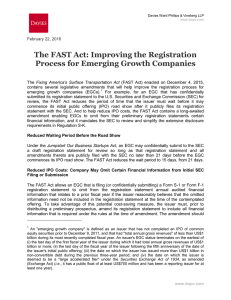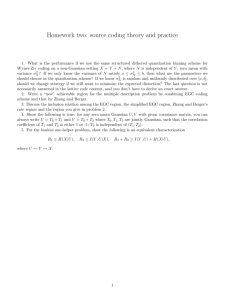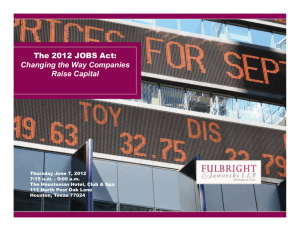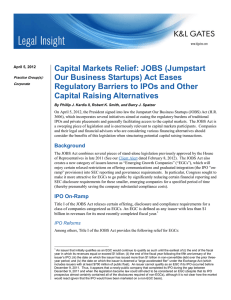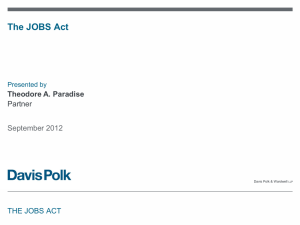FAST Act Continues Capital Formation Initiatives of the JOBS Act Overview
advertisement
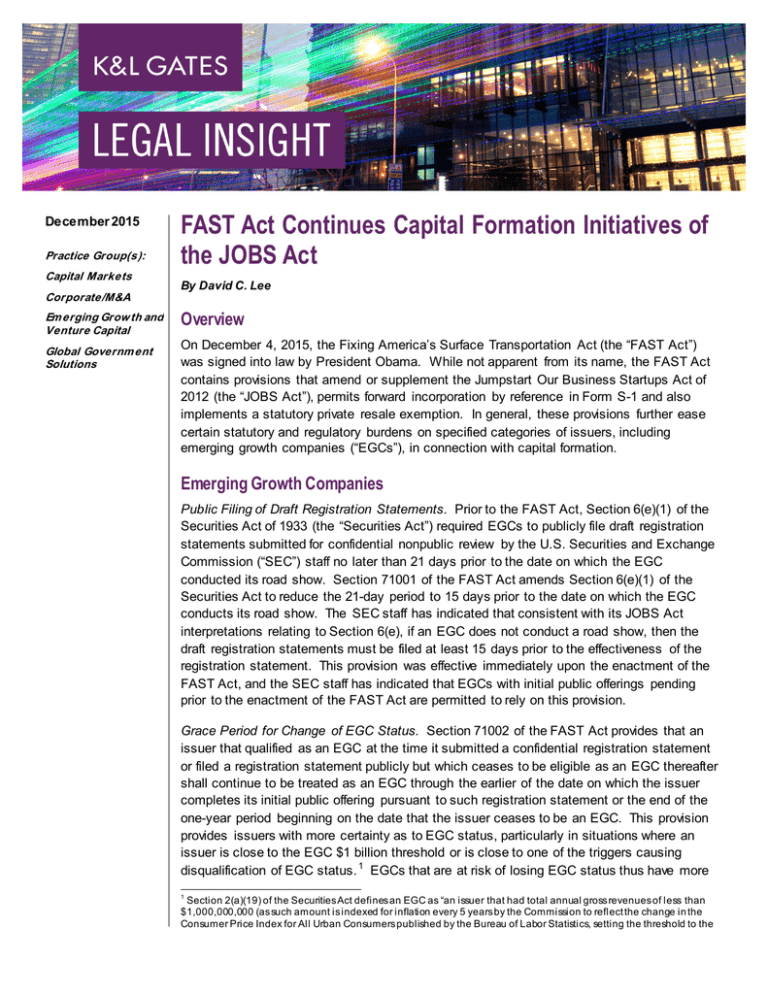
December 2015 Practice Group(s): Capital Markets FAST Act Continues Capital Formation Initiatives of the JOBS Act By David C. Lee Corporate/M&A Em erging Grow th and Venture Capital Global Governm ent Solutions Overview On December 4, 2015, the Fixing America’s Surface Transportation Act (the “FAST Act”) was signed into law by President Obama. While not apparent from its name, the FAST Act contains provisions that amend or supplement the Jumpstart Our Business Startups Act of 2012 (the “JOBS Act”), permits forward incorporation by reference in Form S-1 and also implements a statutory private resale exemption. In general, these provisions further ease certain statutory and regulatory burdens on specified categories of issuers, including emerging growth companies (“EGCs”), in connection with capital formation. Emerging Growth Companies Public Filing of Draft Registration Statements. Prior to the FAST Act, Section 6(e)(1) of the Securities Act of 1933 (the “Securities Act”) required EGCs to publicly file draft registration statements submitted for confidential nonpublic review by the U.S. Securities and Exchange Commission (“SEC”) staff no later than 21 days prior to the date on which the EGC conducted its road show. Section 71001 of the FAST Act amends Section 6(e)(1) of the Securities Act to reduce the 21-day period to 15 days prior to the date on which the EGC conducts its road show. The SEC staff has indicated that consistent with its JOBS Act interpretations relating to Section 6(e), if an EGC does not conduct a road show, then the draft registration statements must be filed at least 15 days prior to the effectiveness of the registration statement. This provision was effective immediately upon the enactment of the FAST Act, and the SEC staff has indicated that EGCs with initial public offerings pending prior to the enactment of the FAST Act are permitted to rely on this provision. Grace Period for Change of EGC Status. Section 71002 of the FAST Act provides that an issuer that qualified as an EGC at the time it submitted a confidential registration statement or filed a registration statement publicly but which ceases to be eligible as an EGC thereafter shall continue to be treated as an EGC through the earlier of the date on which the issuer completes its initial public offering pursuant to such registration statement or the end of the one-year period beginning on the date that the issuer ceases to be an EGC. This provision provides issuers with more certainty as to EGC status, particularly in situations where an issuer is close to the EGC $1 billion threshold or is close to one of the triggers causing disqualification of EGC status. 1 EGCs that are at risk of losing EGC status thus have more 1 Section 2(a)(19) of the Securities Act defines an EGC as “an issuer that had total annual gross revenues of less than $1,000,000,000 (as such amount is indexed for inflation every 5 years by the Commission to reflect the change in the Consumer Price Index for All Urban Consumers published by the Bureau of Labor Statistics, setting the threshold to the FAST Act Continues Capital Formation Initiatives of the JOBS Act flexibility in the event that they lose EGC status in that they can either complete their initial public offering or have a one-year period from the time that they lose EGC status, whichever comes first. This provision was effective immediately upon the enactment of the FAST Act, and the SEC staff has indicated that EGCs with registration statements pending at the time of the enactment of the FAST Act are permitted to rely on this provision. Financial Statements. Section 102 of the JOBS Act reduced certain required disclosures for issuers that qualified as EGCs, such as reducing financial statement requirements to two years of audited financial statements. Section 71003 amends Section 102 of the JOBS Act to further reduce the burdens of financial statements by providing that a registration statement on Form S-1 or Form F-1 filed by an issuer prior to its initial public offering is permitted to omit financial information for historical periods otherwise required by Regulation S-X when it files its registration statement (or submits its confidential submission), provided that (1) the omitted financial information relates to a historical period that the issuer reasonably believes will not be required to be included in the Form S-1 or Form F-1 at the time of the contemplated offering, and (2) prior to the distribution of the preliminary prospectus to investors, such registration statement is amended to include all financial information required by Regulation S-X at the date of such amendment. This provision provides issuers with significant benefits in avoiding unnecessary cost and burden in preparing and producing financial statements when such financial statements would not be required to be included in the registration statement at the time of the contemplated offering. The language of Section 71003 is not entirely clear as to whether acquisition financial statements required by Rule 3-05 of Regulation S-X are covered by its terms. The SEC staff issued Compliance and Disclosure Interpretations on December 10, 2015, clarifying that Section 71003 is not limited to issuer financial statements and that issuers can therefore omit financial statements of third parties under this provision of the FAST Act. 2 The SEC staff has also indicated that it would not object if EGCs apply this provision immediately. Another ambiguity in the language contained in Section 71003 relates to what point in time is meant by the phrase “at the time of the contemplated offering.” Is it the time that marketing of the offering commences, e.g., the distribution of the preliminary prospectus or the commencement of the roadshow? Or is it the time of effectiveness of the registration statement relating to the offering? One view is that “at the time of the contemplated offering” refers to the time that the preliminary prospectus is distributed, which would be consistent with the statutory language requiring that prior to the distribution of the preliminary prospectus, the registration statement must be amended to include all required financial nearest 1,000,000) during its most recently completed fiscal year.” An issuer that qualifies as an EGC continues its status as an EGC until the earliest of (1) the last day of the fiscal year of the issuer during which it had total annual gross revenues of $1 billion or more; (2) the last day of the fiscal year of the issuer following the fifth anniversary of the date of the first sale of common equity securities of the issuer pursuant to an effective registration statement; (3) the date on which the issuer has, during the previous three-year period, issued more than $1 billion in nonconvertible debt; or (4) the date on which the issuer is deemed to be a large accelerated filer. 2 See Fixing America’s Surface Transportation (FAST) Act Compliance and Disclosure Interpretations (December 10, 2015), available at http://www.sec.gov/divisions/corpfin/guidance/fast-act-interps.htm. 2 FAST Act Continues Capital Formation Initiatives of the JOBS Act information. However, the language is not clear, and the SEC staff has not as of yet issued any clarifying written guidance. Section 71003 directs the SEC to adopt amendments to Forms S-1 and F-1; however, it appears that Section 71003 also provides that this provision is effective 30 days after the enactment of the FAST Act, which may be intended to provide issuers with relief in the event that the SEC has not completed the amendments to Form S-1 and Form F-1 by that time. Forward Incorporation in Form S-1 Section 84001 requires the SEC to, no later than 45 days after the enactment of the FAST Act, revise Form S-1 to permit smaller reporting companies to incorporate by reference filings made with the SEC after the effectiveness of the registration statement, i.e., forward incorporation by reference. This revision will provide smaller reporting companies with the welcome ability to avoid the necessity to file either prospectus supplements or post-effective amendments, as necessary, to outstanding Forms S-1 when such issuers file Forms 10-K, 10-Q, and 8-K. This comes up often in instances where an issuer has filed resale registration statements that are required to be outstanding due to registration rights covenants that require such issuer to maintain effective registration statements for a specified period of time. Disclosure Effectiveness Form 10-K. Section 72001 of the FAST Act requires the SEC to issue rules permitting issuers to submit a summary page on Form 10-K, provided that each item on such a summary page includes a cross-reference, by electronic link or otherwise, to the disclosure in the Form 10-K to which such item relates. This rulemaking is required within 180 days following the enactment of the FAST Act. Issuers are currently permitted to provide a summary page in their Form 10-K filings so long as they fairly present the material information in the Form 10-K. Regulation S-K. Section 72002 of the FAST Act requires the SEC to (1) revise Regulation SK to further scale or eliminate Regulation S-K requirements to reduce burdens on EGCs, accelerated filers, smaller reporting companies, and other smaller issuers, while continuing to provide all material information to investors, and (2) eliminate duplicative, overlapping, outdated, or unnecessary provisions of Regulation S-K. Section 72003 of the FAST Act requires yet another study on Regulation S-K 3, which should (1) determine how best to modernize and simplify Regulation S-K requirements in a way that reduces the costs and burdens on issuers, yet still provides all material information; (2) emphasize a company-bycompany approach that allows relevant and material information to be disseminated to investors without boilerplate language or static language, while preserving completeness and 3 Section 108(a) of the JOBS Act required the SEC to review Regulation S-K for purposes of determining how its requirements could be updated to modernize and simplify the registration process and reduce costs and burdens associated with the requirements of Regulation S-K for EGCs. Section 108(b) of the JOBS Act required a report of such review. 3 FAST Act Continues Capital Formation Initiatives of the JOBS Act comparability of information across issuers; and (3) evaluate methods of information delivery and presentation and explore methods for discouraging repetition and the disclosure of immaterial information. The SEC is required to consult with the Investor Advisory Committee and the Advisory Committee on Small and Emerging Companies with respect to the above study and to submit a report to Congress no later than 360 days from the enactment of the FAST Act. Statutory Private Resale Exemption In addition to the capital formation-related provisions discussed above, Section 76001 of the FAST Act adds Section 4(a)(7) to the Securities Act, which provides an exemption for private resale transactions. Specifically, new Section 4(a)(7) provides an exemption from the registration requirements of Section 5 of the Securities Act for resale transactions satisfying the following requirements: (1) each purchaser is an accredited investor as defined in Securities Act Rule 501(a) of Regulation D; (2) neither the seller nor any person acting on behalf of the seller offers or sells the securities by any form of general solicitation or general advertising; (3) where the securities are of an issuer that is not subject to Section 13 or 15(d) of the Securities Exchange Act of 1934 (the “Exchange Act”) nor exempt under Exchange Act Rule 12g3-2(b) nor a foreign government eligible to register securities under Schedule B, the seller and the prospective purchaser obtain from the issuer, upon request of the seller, and the seller in all cases makes available to the prospective purchaser, specified information regarding the issuer; (4) the issuer or any of its subsidiaries is not the seller of the securities in question; (5) neither the seller nor any person that has been or will be paid, directly or indirectly, remuneration or a commission for their participation in the offer or sale of the securities, including solicitation of purchasers for the seller, is subject to an event that would disqualify an issuer or other covered person under Securities Act Rule 506(d)(1) of Regulation D or is subject to a statutory disqualification under Section 3(a)(39) of the Exchange Act; (6) the issuer is engaged in business, is not in the organizational stage or in bankruptcy or receivership, and is not a blank check, blind pool, or shell company that has no specific business plan or purpose or has indicated that the issuer’s primary business plan is to engage in a merger or combination of the business with, or an acquisition of, an unidentified person; and (7) the transaction is with respect to a security of a class that has been authorized and outstanding for at least 90 days prior to the date of the transaction. Securities that are acquired in a Section 4(a)(7) exempt transaction are deemed to have been acquired in a transaction not involving any public offering and are thus deemed restricted. In addition, transactions under Section 4(a)(7) are not deemed to be a distribution for purposes of Section 2(a)(11) of the Securities Act, and securities sold in Section 4(a)(7) transactions are covered securities for purposes of Section 18(b)(4) of the Securities Act and thus have the benefit of federal preemption. Section 4(a)(7) was effective immediately upon the enactment of the FAST Act. 4 FAST Act Continues Capital Formation Initiatives of the JOBS Act Author: Dav id C. Lee dav id.lee@klgates.com +1.949.623.3596 5 FAST Act Continues Capital Formation Initiatives of the JOBS Act Anchorage Austin Fort Worth Frankfurt Orange County Beijing Berlin Harrisburg Palo Alto Paris Boston Hong Kong Perth Brisbane Houston Pittsburgh Brussels London Portland Charleston Los Angeles Raleigh Charlotte Melbourne Research Triangle Park Chicago Miami Dallas Milan San Francisco Doha Newark Dubai New York São Paulo Seattle Seoul Shanghai Singapore Sydney Taipei Tokyo Warsaw Washington, D.C. Wilmington K&L Gates comprises approximately 2,000 lawyers globally who practice in fully integrated offices located on five continents. The firm represents leading multinational corporations, growth and middle-market companies, capital markets participants and entrepreneurs in every major industry group as well as public sector entities, educational institutions, philanthropic organizations and individuals. For more information about K&L Gates or its locations, practices and registrations, visit www.klgates.com. This publication is for informational purposes and does not contain or convey legal advice. The information herein should not be used or relied upon in regard to any particular facts or circumstances without first consulting a lawyer. © 2015 K&L Gates LLP. All Rights Reserved. 6

